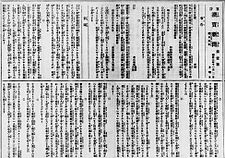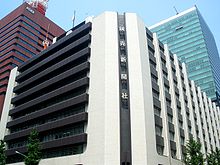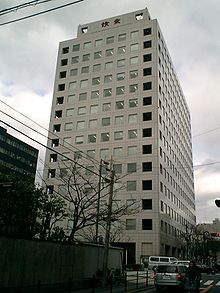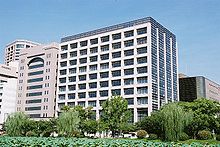- Yomiuri Shimbun
-
Yomiuri Shimbun 
The front page of the paper's first issue on November 2, 1874Type Daily newspaper Format Broadsheet Owner Yomiuri Group Founded 1874 Headquarters Otemachi, Chiyoda, Tokyo, Japan Circulation 14,067,000 (2005) Official website yomiuri.co.jp The Yomiuri Shimbun (読売新聞) is a Japanese newspaper published in Tokyo, Osaka, Fukuoka, and other major Japanese cities.[1] It is one of the five national newspapers in Japan; the other four are the Asahi Shimbun, the Mainichi Shimbun, Nihon Keizai Shimbun, and the Sankei Shimbun. The headquarters is located in Otemachi, Chiyoda, Tokyo.[2]
Founded in 1874, the Yomiuri Shimbun is credited with having the largest newspaper circulation in the world[3][4] having a combined morning and evening circulation of 14,323,781 through January 2002. The paper is printed twice a day and in several different local editions.
Yomiuri Shimbun established the Yomiuri Prize in 1948. Its winners include Yukio Mishima and Haruki Murakami.
Contents
Political stance
The Yomiuri Shimbun is conservative and sometimes considered a centre-right newspaper.[5]
For example, The New York Times reported that "The nation's largest newspaper, Yomiuri Shimbun, applauded the revisions" regarding removing the word "forcibly" from referring to laborers brought to Japan in the prewar period and revising the comfort women controversy.[6] More recently the Yomiuri editorials have opposed the DPJ government.
Other publications and ventures
Yomiuri also publishes The Daily Yomiuri, Japan's largest English-language newspaper. It publishes the daily Hochi Shimbun, a sport-specific daily newspaper, as well as weekly and monthly magazines and books.
Yomiuri Shimbun Holdings owns the Chuokoron-Shinsha publishing company, which it acquired in 1999, and the Nippon Television network.
It is a member of the Asia News Network.
The Yomiuri Shimbun is known as the de facto financial patron of the baseball team Yomiuri Giants and the football club Tokyo Verdy 1969. They also sponsor the Japan Fantasy Novel Award annually.
Yomiuri Shimbum has been a sponsor of the FIFA Club World Cup every time it has been held in Japan since 2006.
History
The Yomiuri was launched in 1876 by the Nisshusha newspaper company as a small daily newspaper. Throughout the 1880s and 1890s the paper came to be known as a literary arts publication with its regular inclusion of work by writers such as Ozaki Kōyō.
In 1924, Shoriki Matsutaro took over management of the company. His innovations included sensational news coverage, a full-page radio program guide, and the establishment of Japan's first professional baseball team (now known as the Yomiuri Giants).
The emphasis of the paper shifted to broad news coverage aimed at readers in the Tokyo area. By 1941 it had the largest circulation of any daily newspaper in the Tokyo area. In 1942, under wartime conditions, it merged with the Hochi Shimbun and became known as the Yomiuri-Hochi.
In February 2009, tie-up with The Wall Street Journal for edit, printing and distribution, then from March the major news of headline of WSJ Asian edition is summarized on evening edition in Japanese.
The Yomiuri has a history of promoting nuclear power within Japan. During the 1950s Matsutaro Shoriki, the head of the Yomiuri, agreed to use his newspaper to promote nuclear power in Japan for the CIA.[7] In May 2011, when Japanese prime minister Naoto Kan requested Chubu Electric Power Company to shut down several of its Hamaoka Nuclear Power Plants due to safety concerns, the Yomiuri responded with criticism, calling the move "abrupt" and a difficult situation for Chubu Electric's shareholders. It wrote Kan "should seriously reflect on the way he made his request."[8] It then followed up with an article wondering about how dangerous Hamaoka really was and called Kan's request "a political judgment that went beyond technological worthiness." [9] The next day damage to the pipes inside the condenser was discovered at one of the plants following a leak of seawater into the reactor.[10]
Digital resources
In November 1999, The Yomiuri Shimbun released a CD-ROM titled "The Yomiuri Shimbun in the Meiji Era," which provided searchable archives of news articles and images from the period that have been digitalized from microfilm. This was the first time a newspaper made it possible to search digitalized images of newspaper pictures and articles as they appeared in print.
Subsequent CD-ROMs, "The Taisho Era", "The prewar Showa Era I", and "The prewar Showa era II" were completed eight years after the project was first conceived. "Postwar Recovery", the first part of a postwar Showa Era series that includes newspaper stories and images until 1960, is on the way.
The system of indexing each newspaper article and image makes the archives easier to search, and the CD-ROMs have been well received by users as a result. This digital resource is available in most major academic libraries in the United States.
Locations
- Tokyo Head Office
- 1-7-1, Otemachi, Chiyoda, Tokyo, Japan
- Osaka Head Office
- 5-9, Nozakicho, Kita-ku, Osaka, Japan
- West Japan Head Office
- 1-16-5, Akasaka, Chūō-ku, Fukuoka, Japan
Yomiuri Group
- Yomiuri Giants
- Nippon Television Network Corporation
- Yomiuri Telecasting Corporation
- Chuokoron-Shinsha, Inc.
- Yomiuri Land, an amusement park
- Yomiuri Advertising Agency (also known as "Yomiko")
See also
- Japanese media
- Jake Adelstein
References
- ^ There is approx. 30 Yumiuri Printing factory (印刷工場) throughout Japan.
- ^ "組織体制." Yomiuri Shimbun. Retrieved on March 5, 2010.
- ^ World Association of Newspapers: World’s 100 Largest Newspapers, 2005
- ^ Schell, Orville. "Japan's war guilt revisited". http://www.nationmultimedia.com/2007/01/01/opinion/opinion_30022999.php. Retrieved 06-12-31.
- ^ Brooke, James. "Japan Hopes to Use Aid to Press North Korea to End A-Bomb Plan." The New York Times. October 19, 2002. Retrieved on February 26, 2009.
- ^ Norimitsu Onishi. "Japan's reach for future runs up against the past." The New York Times. Thursday, April 7, 2005.
- ^ http://search.japantimes.co.jp/cgi-bin/fd20110522pb.html
- ^ http://www.yomiuri.co.jp/dy/editorial/T110510004049.htm
- ^ http://www.yomiuri.co.jp/dy/national/T110520004807.htm
- ^ http://www.japantoday.com/category/national/view/pipes-inside-condenser-found-damaged-at-hamaoka-nuclear-plant
External links
- Yomiuri Shimbun Online (Japanese)
- Daily Yomiuri Online (English)
- Guinness World Record: Highest Daily Newspaper Circulation[dead link]
- Yomiuri Advertising Agency (Japanese)
Japanese Newspapers The five newspapers Block newspapers Hokkaido Shimbun - Kahoku Shinpō - Chunichi Shimbun (Tokyo Shimbun) - Chugoku Shimbun - Nishinippon ShimbunOther leading newspapers Shizuoka Shimbun - Niigata Nippō - Kyoto Shimbun - Kobe Shimbun -
Jōmō Shimbun - Sanyo Shimbun - Yamaguchi ShimbunOthers Seikyo Shimbun - Shimbun Akahata - Nihon Nōgyō Shimbun - Minato Shimbun - Kōmei Shimbun - Sekai NippōCategories:- Newspapers published in Japan
- Companies based in Tokyo
- Publications established in 1874
- English-language newspapers published in Japan
- Conservatism in Japan
- 1874 establishments in Japan
Wikimedia Foundation. 2010.



